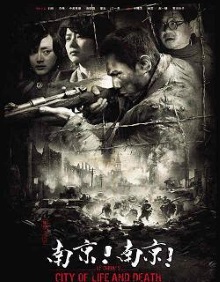
The Nanking Massacre is well known as a rallying call for Chinese nationalism and a sore point of contention in Sino-Japanese relations. Given the prickliness of Chinese pride in recent years, it was always doubtful that China could be capable of producing an even-handed account of the tragedy. City of Life and Death however has been excellent reviews by a number of foreign critics so I thought it might be worth watching.
As it turns out, I think those critics are wrong and this is a poor film. It does have all the trappings of a good one. Its subject matter is rich and it is technically competent. The cast appears to be solid. The film is even shot in black and white which both accentuates its seriousness and helps it emulate the style of better films. Unfortunately while the director does try, he falls far short of what it takes.
Let’s start with how the film fails to establish a solid sense of time and place. A desultory effort is made here with a montage of postcards which supposedly details the invasion of China and the siege of Nanjing. But it is both kitschy and almost unreadable. Similarly the audience is never properly introduced to the main characters. We just see them thrown into the chaos with no idea of who they are and what they do. The sole exception to this is the Japanese soldier Kadokawa Masao.
For this reason, while the audience is able to achieve some rapport with Kadokawa, we feel little empathy with any of the characters on the Chinese side. We see them suffer and we see them die but as my wife notes, they’re just meat bodies. They don’t feel like real people, so there is no sense of tragedy. The extensive battle scenes at the beginning suffer from a similar failure. Lots of action, but we view it from a remove instead of through the eyes of a particular character so it’s dispassionate and distant.
This is exacerbated by a lack of basic directorial skills. The film seems to be unable to resist resorting to clichéd visual flourishes such as a hand sticking out of a pile of dead bodies, the old standby of plucking out a cigarette from someone’s mouth and grinding it under someone’s feet to communicate grimness or playing with flowers as a metaphor for joy. This suggests that the director lacks a good sense of the visual language of cinema and relies on recycling old tropes.
Similarly, the pacing is completely out of whack and scenes follow one another in ways that are tonally dissonant. The extended scene of the Japanese soldiers honouring their dead is one such example. In general, the film uses the dramatic slowdown so often that it loses any power. The end result of attempting to infuse dramatic weight into every scene is that every scene feels equally flat. This irritates and eventually bores the audience.
To be fair, it is laudable that the director does actually try. This is a far cry from the mindless anti-Japanese propaganda that fills Chinese television screens. It is regrettable that even this minor effort to portray the Japanese side of the story from the point of view of a more or less sympathetic Japanese soldier ran into serious opposition in China and the film had to endure a far higher level of scrutiny from official censors than the norm.
But in the end, however ambitious and well-intentioned it may be, this is just a badly made film. The Nanking Massacre is a terrible tragedy that ought to be remembered. Unfortunately this film fails to give us any reason to do so.